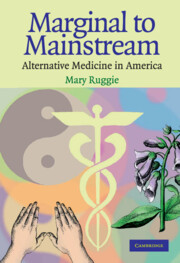Book contents
- Frontmatter
- Contents
- List of Tables
- List of Acronyms
- Preface
- 1 Introducing CAM … and the Many Questions It Raises
- 2 Understanding CAM: The Problem of Knowledge and the Power of Words
- 3 The Growth of CAM: Patterns of Use and Meaning
- 4 Physicians: Learning New Ways
- 5 Medical Research: Science and Interpretation
- 6 Investigating CAM: What Works?
- 7 The Road Ahead: Accommodation or Integration?
- Bibliography
- Index
3 - The Growth of CAM: Patterns of Use and Meaning
Published online by Cambridge University Press: 05 June 2012
- Frontmatter
- Contents
- List of Tables
- List of Acronyms
- Preface
- 1 Introducing CAM … and the Many Questions It Raises
- 2 Understanding CAM: The Problem of Knowledge and the Power of Words
- 3 The Growth of CAM: Patterns of Use and Meaning
- 4 Physicians: Learning New Ways
- 5 Medical Research: Science and Interpretation
- 6 Investigating CAM: What Works?
- 7 The Road Ahead: Accommodation or Integration?
- Bibliography
- Index
Summary
CAM has become one of the fastest growing fields in health care. In 1991, approximately 33% of respondents to a survey were using at least one type of unconventional therapy annually and the total number of visits to unconventional practitioners exceeded the number of visits to all primary care physicians in the United States (Eisenberg et al. 1993). Expenditures on these therapies and practitioners at that time were estimated at about $14 billion per year, $10.5 billion of which was paid out of pocket, an amount comparable to out-of-pocket expenditures for all hospitalizations in the United States. The survey was repeated in 1997, and it found substantial increases (Eisenberg et al. 1998). Approximately 42% of the respondents were using alternative medicine and, once again, they were visiting alternative practitioners more than primary care physicians. Also, expenditures on alternative medicine had grown to about $21 billion, $12 billion of which was out of pocket. According to various estimates, Americans are currently spending more than $20 billion on dietary supplements alone.
There are a number of other dimensions to the growth of CAM on both supply and demand sides, indicating that it has become a widespread phenomenon. For instance, several new colleges or schools have sprouted across the U.S. to train CAM practitioners, and increasingly more medical schools are offering elective courses on CAM.
- Type
- Chapter
- Information
- Marginal to MainstreamAlternative Medicine in America, pp. 43 - 74Publisher: Cambridge University PressPrint publication year: 2004



